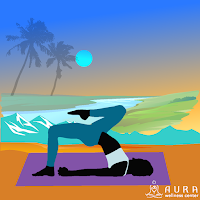When most people think of yoga practice (well, at least those without direct experience with it), they think of Warrior Postures and sustained stretches to “touch your toes”. To the contrary, we yoga instructors and enthusiasts know that asana practice can be quite dynamic and fluid. This is easy enough to understand with Vinyasa–style practice, which itself means “flow” in Sanskrit. Hatha-style practice can be dynamic as well, however. By adding this type of vibrant movement in your sequences, you can lead your students to develop more refined proprioception (the sense of body parts relating and working together in space), coordination, balance, and spacial awareness.
Seeing as we live in a largely sedentary culture, those developments can enhance our students’ long-term holistic wellness. Along the way, each practice can be more intriguing and enjoyable. If we can combine breath, movement, awareness of the body and its possibilities, and a bit of creativity, we can allow any type of asana practice to be a bit more interesting – and just plain fun! This will keep our students coming back to our classes and otherwise remaining committed to their practices. As a choreographer, dancer, Registered Dance/Movement Therapist and CYT 500, I’ll offer the following guidelines for adding some “spice” to your sequences.
1) Play with levels in space.
For instance, after cueing your students to reach upwards in Urdhva Hastasana (Upward Salute), instruct them to fold forward into Uttanasana (Standing Forward Fold) or to step back into Anjaneyasana (Runner’s Lunge) from there. Just had your students experiencing upwards, expansive energy in a Warrior I Pose? Try taking that to a Humble Warrior variation, to bring that energy into something more rooted and grounded. Sun and Moon Salutations variations have these level changes, of course – but we instructors can use that wise approach when we create fresh, new variations on these sequences. Through that, we can help students move their bodies through space more efficiently and safely – as well as simply have a little more fun. We instructors should ensure students don’t move their heads to drastically different levels too quickly, however, which can create dizziness.
2) Play with tempos.
We can also make our sequences more interesting and enjoyable through combining slower and faster tempos, just like a composer creating a musical score. For example, after a flow such as Cat-Cow, or Runner’s Lunge-Pyramid Pose, cue a sustained stretch, core-supported pose, or restful posture. From Cat-Cow, that could be Spinal Balance (more active) or Thread-the-Needle (more restful). We can also offer guidance on pranayama with this approach; the type of breath that best supports Thread-the-Needle has a slower rhythm than the one that best supports Cat-Cow, of course. Additionally, this is a place when we can coordinate the music we play (if we do) in our classes with specific postures and flows. Creating playlists can be an art form, so be creative and have fun! Building their abilities to move and breathe at different tempos can enhance students’ enjoyment of living and moving in their bodies every day.
3) Take joints through their full ranges of motion.
For instance, in the twisted variation of Crescent Lunge, cue students to take “Rock Star” swings (like a guitar player making big arm circles) with the raised arm. That’ll bring the shoulder joint through its full range of motion. For the hip joint, try a sequence such as Standing Single Leg Balance to Airplane to Standing Split. Moving joints through their possible ranges in these ways can help students feel energetic and expansive - like dancers offering optimal energy in performance, in beautiful flow. A key goal of asana practice is to bring energy from one’s core to the body’s peripheries. Guiding our students to move their joints through full ranges of motion can help achieve that. It can also help make every-day functioning smoother and more efficient, as well as contribute to improved long-term joint health. Students most likely won’t be thinking about that, however, when they’re having a good time moving freely in our classes!
4) Move around the mat.
In asana classes, the default is facing the same direction the entire class. Just like with inversions, sequencing so that students face different parts of the room can offer them fresh perspectives - literally and metaphorically. This could be through single postures, such as facing the sides of the room with Parighasana (Gate Posture), Warrior II, Trikonasana (Triangle Pose) and Extended Side-Angle Pose. You could create different facings (the directions they face) for your students in even more intriguing, flowing ways - you can (and maybe you have) created full sequences that do just that. For instance, this week I'm teaching a balance sequence of Dancer's Pose into Airplane, which then grounds into a Runners' Lunge, shifts to Goddess Pose, switches to Runner's Lunge on the other side and ends in Tree Pose at the other side (you might call it the "back") of the mat. The whole sequence goes back to the other side (the "front") of the mat on the other leg. There are even ways to switch facings mid-posture. When I'm a student, I really enjoy when my instructor cues switching sides in Gomukasana (Cowface Posture) or Half-Lord-of-the-Fishes Pose by spinning to face the other side of the mat and then back to the front with the other leg on top in the posture. It can be a fun little trick that adds further joy and a sense of personal empowerment to asana practice - certainly things we want to help guide out students towards!
Please stay tuned for a following article where I’ll offer further tips for creating these sequences in our busy teaching schedules, and then delivering them to different types of students. Om Shanti!
© Copyright – Aura Wellness Center – Publications Division
See our testimonials to find out what our graduates have to say about our selection of online yoga teacher certification courses.








